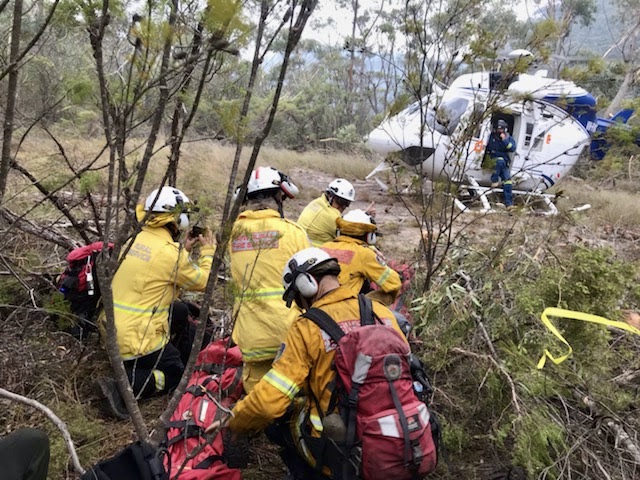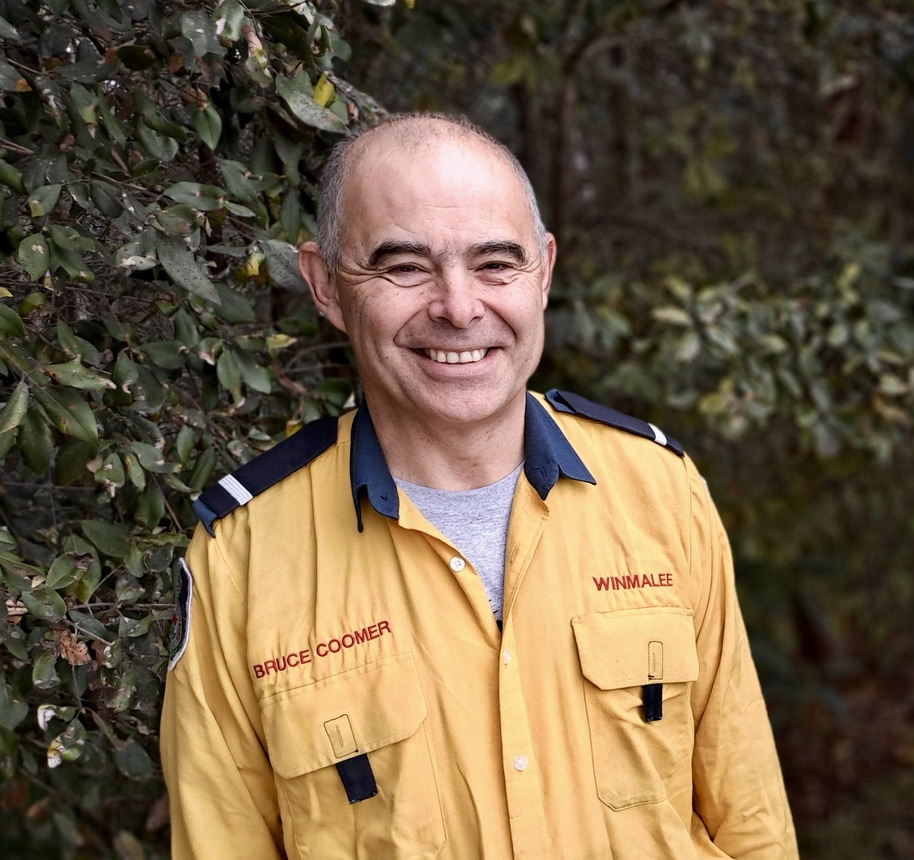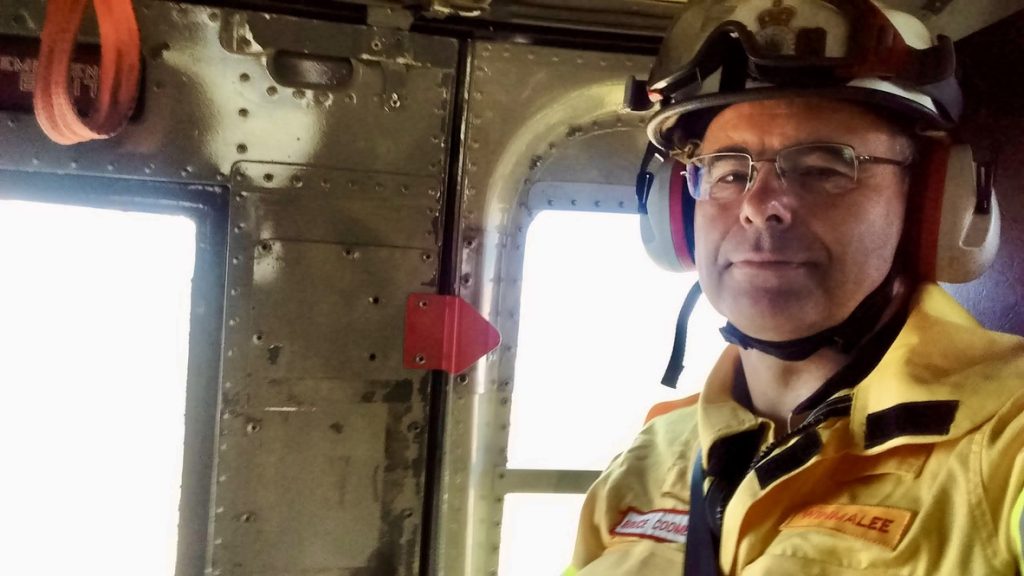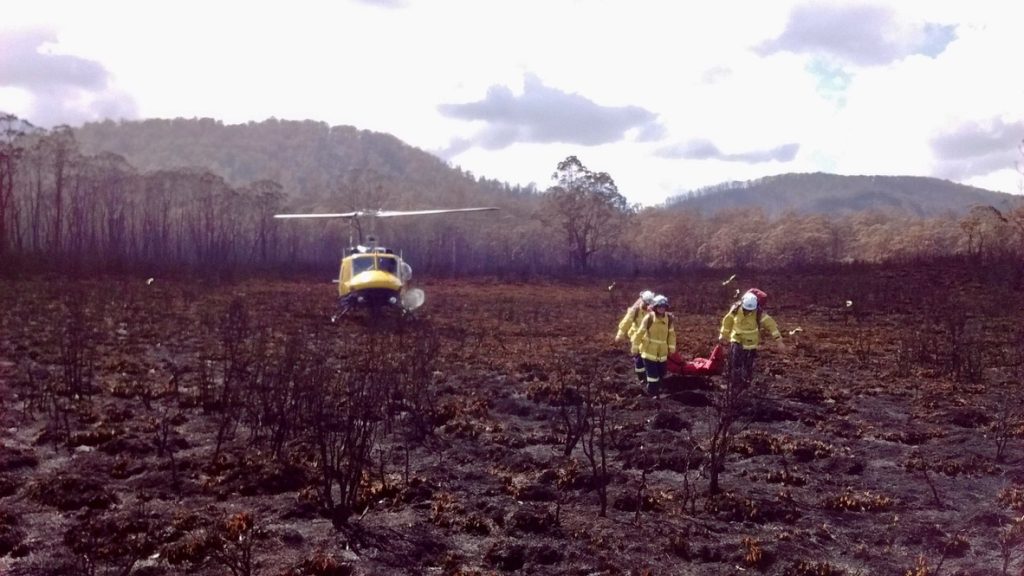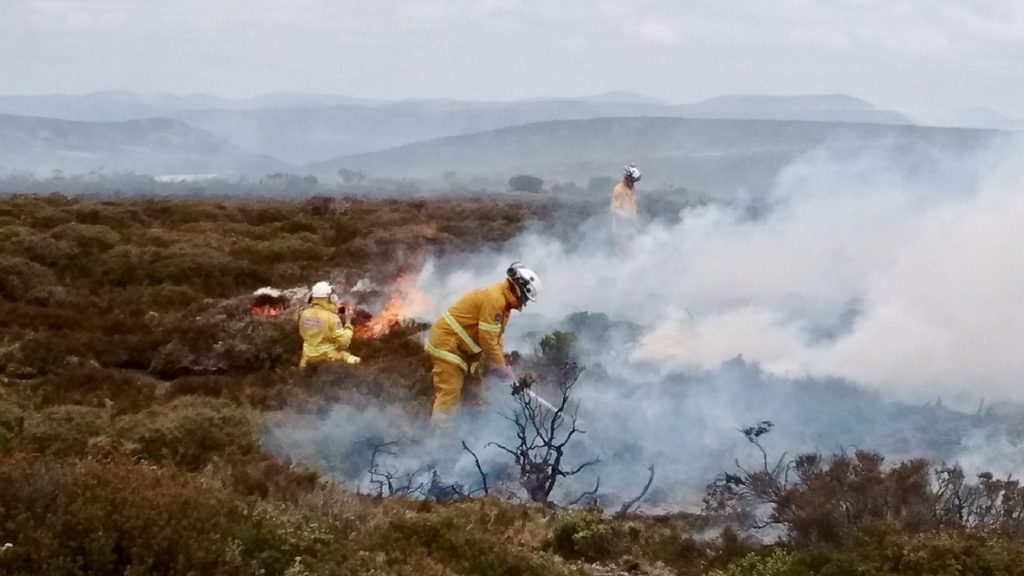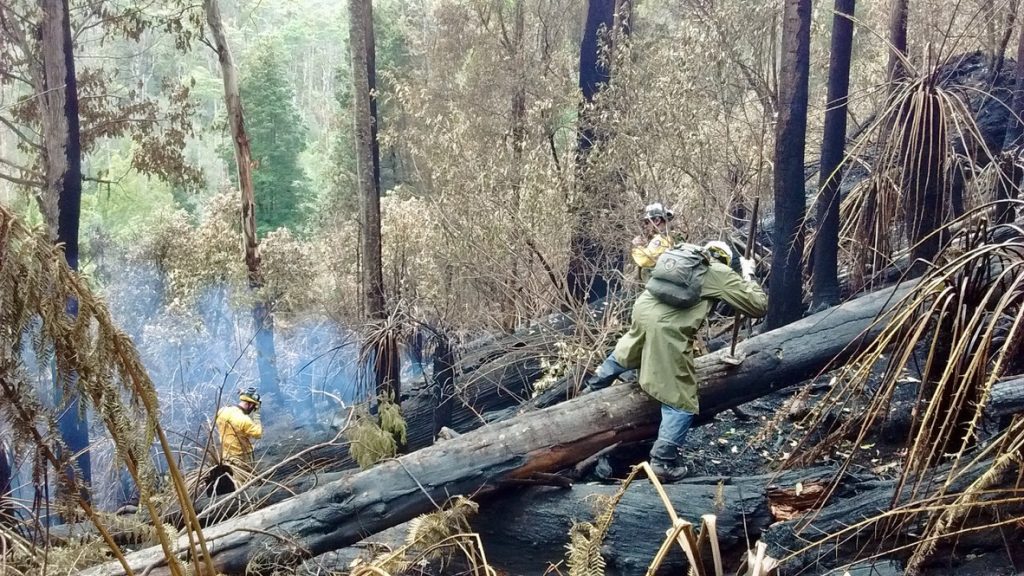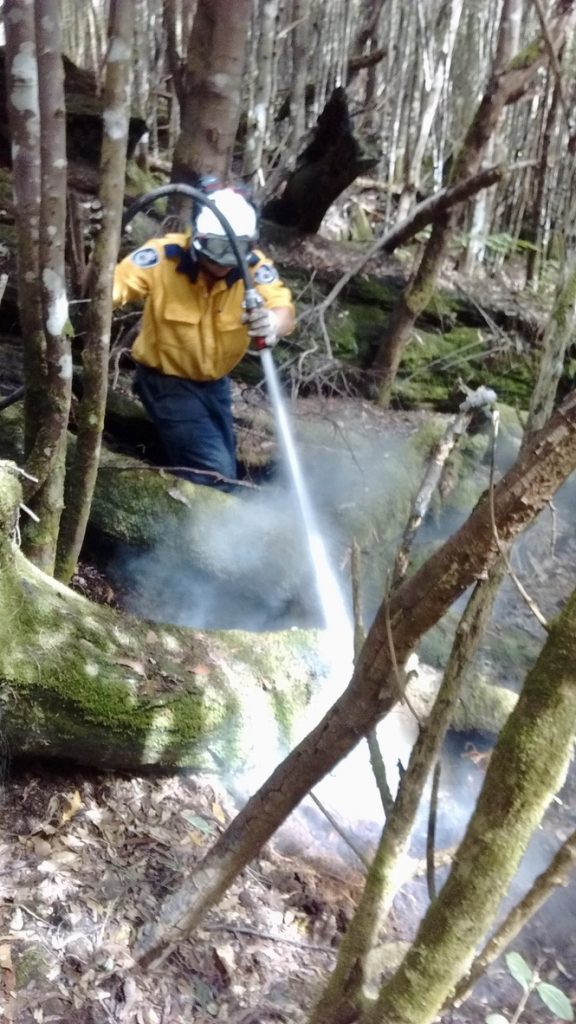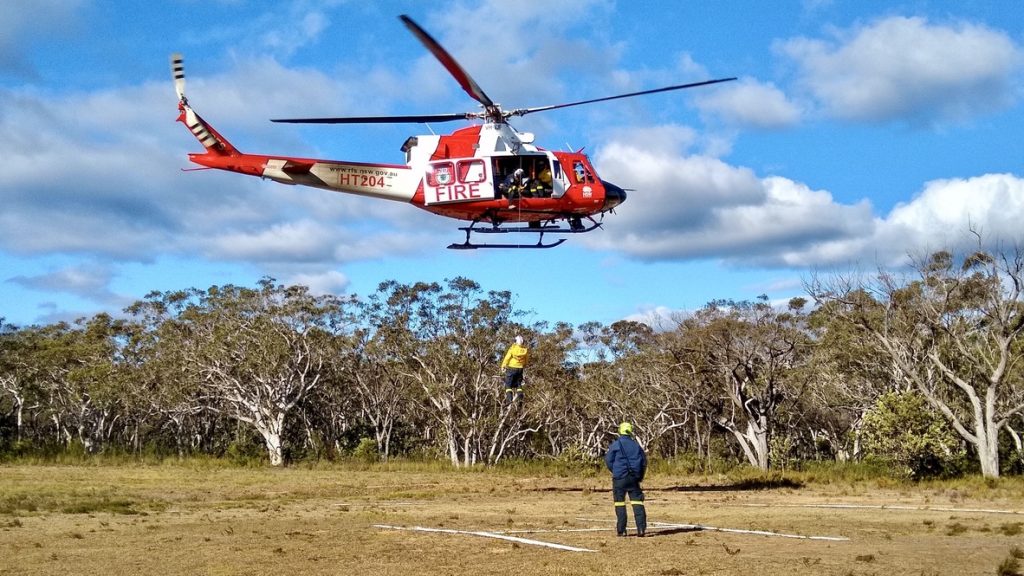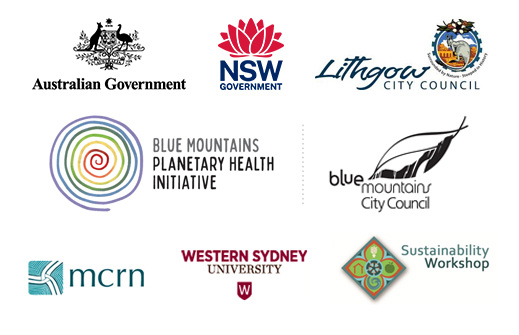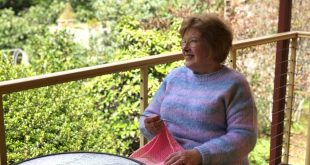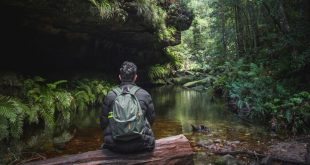Bruce Coomer and fellow NSW Rural Fire Service (RFS) Remote Area Firefighting Team members about to board a helicopter at Linden Ridge, in the Blue Mountains National Park, in January 2020. The crew contained an advancing fire outbreak on Linden Ridge that was threatening Winmalee and Hawkesbury Heights (Bruce Coomer).
By Julie Nance
Fighting bushfires in rugged, mountainous terrain inaccessible by fire tankers requires considerable skill and endurance. Winmalee’s Bruce Coomer has spent 20 years battling fires deep in the bush as a volunteer remote area firefighter. He shares his experiences with writer Julie Nance.
Key Points:
- It is important to put remote bushfires out before they grow bigger and reach populated areas.
- Rural Fire Service (RFS) volunteers like Bruce Coomber have a wealth of vital experience in fighting remote fires.
- The RFS is always needing more volunteers and remote area firefighting is just one of the many roles available.
Every year for the past two decades Bruce has passed the ‘arduous pack test’, carrying 20kg over 4.83kms in 45 minutes or less. It’s one of several requirements to be part of a Remote Area Firefighting Team (RAFT).
Once you have either walked or been helicoptered into the fireground, you need to be self-reliant, including overnight. That means carrying personal belongings, food, water, thermal cameras and a mixture of hand tools. Divided between the crew of three to six are chainsaws for tree felling operations, spare chains, fuel, oil and the list goes on!
Bruce Coomer, Deputy Captain, Winmalee Rural Fire Brigade. Bruce has been in the NSW Rural Fire Service for 29 years (Julie Nance).
Bruce explains the role of a volunteer remote area firefighter
“I’ve done a lot of remote firefighting work in Australia. I’ve been to Tasmania about 10 times, all over NSW, Victoria, the ACT and overseas as well. There is always work to be done and not enough people to do it.
If you like the bush and the outdoors, it’s a fantastic way to see some amazing places by helicopter or on foot that you wouldn’t ordinarily see. Often these areas are in national parks and you can’t rent a helicopter to go there. The only way you’d ever go there in an aircraft is to put out a fire.
The idea with remote work is to jump on the fire as soon as possible and contain it before it gets bigger.
Where there’s a small fire that has just started, you can winch people in quickly by helicopter. Three or four people can put it out before it becomes something that requires 400 people, dozens of vehicles and house protection. You’ve saved an enormous amount of time, money and resources.
There’s no deployment to flat areas. It’s always mountain goat country you are dropped into. You’re going to attack the fire often at the top of a hill because that’s where lightning has struck. You can’t usually get any trucks there because it’s too steep.
It’s really satisfying to be in a remote location and put out the edge of a smaller fire and stop it dead.
I helped achieve this twice in early 2020 at Linden Ridge and Linden Creek, halfway between Winmalee and Mt Wilson. We were deployed to catch the spot fires or progressing fire. We stopped the fire from impacting Winmalee and Hawkesbury Heights.
Managing risk
I’ve certainly been in situations where we’ve had to stop what we are doing and move to our safe zone. If there is too great a threat, you won’t be deployed in the first place. Inherently as a firefighter there’s an element of risk that you don’t otherwise have sitting on the beach drinking soft drinks. The way to address potential danger is to be well trained and to know what to do at the right time.
Bruce enroute to a fire at Mt Field National Park, west of Hobart, Tasmania, in early January 2019. The remote location required the RAFT to be inserted by helicopter. Winching is more dangerous and is always the last option (Bruce Coomer).
Bruce: Our crew landed in a burnt-out swamp in Mt Field National Park. The red bag contains chainsaws, fuel and hand tools. Starting from burnt ground is always preferred as it is a refuge from active fire. From this point, we walked up the hill to the fire edge, about 1km away (Bruce Coomer).
Firefighting without water
Dry firefighting is all about separating the heat from the fuel in whatever way you can, whether that’s scraping with your hands or using a rakehoe (a long-handled tool). Blowers are quite effective with leaves on the ground in clearing an area. The idea is to make a fire break and either burn from that fire break or have the fire burn up to it. In both instances the fire gets to the point where there’s no fuel left and it stops and goes out.
Bruce: In the Tasmanian highlands in mid-January 2016. It’s a very old and slow growing environment, with some plants taking centuries to grow only a metre or two high. It was a very hot fire, despite the cold conditions. Once the bush started to burn, it was not possible to put it out. We had to try to contain the fire by making a fire break on the unburnt side of the bushes (Bruce Coomer).
Bruce: I was a member of a RAFT helicoptered in and out at Cradle Mountain-Lake St Claire National Park, Tasmania in late January 2016. We worked with Tasmanian Parks and Wildlife Service (PWS) and Tasmanian Fire Service to extinguish a fire edge and contain the fire. Steep country and large fallen trees made it slow going (Bruce Coomer).
Dams dropped from the sky
A ‘buoy wall’ is like a portable dam that comes in varying sizes. The aircraft drops it, and the crew on the ground sets it up. Water – from 500 to 1000 litres – is dropped into the buoy wall by an aircraft, or the water can be pumped in from a dam or a creek. You can then use the water with a pump and hose, or the aircraft comes and picks up the water in a bucket and drops it on the fire where you are working.
One of the most satisfying things is making a dam wall with available rocks and stones so the water dropped by the helicopter stays in the hot zone and puts everything out. You’ve also got water left over to use elsewhere.
You guide the aircraft to drop the water by radio, setting up indicators on the ground or using strobing torches.
Bruce: In a national park near Lake Gordon, West of Hobart, in February 2019, extinguishing a fire edge and containing the fire. There was a resident tiger snake nearby, which we repeatedly observed sunning itself in the same location over a number of days (Bruce Coomer).
RAFT training
To be deployed remotely, you not only need to be trained as a basic firefighter – understanding the risks and how to deal with fire using the standard equipment on a truck – you also need to know about fire behaviour. You need your advanced firefighter training completed, after which you are eligible to complete remote area courses.
RAFT training includes dry firefighting techniques, safety around helicopters, winching, communication and on-off boarding procedures.
Recertification to be part of a RAFT is annual, including the standard fitness test. The recertification winch height is kept quite short at five metres to reduce risk. Actual winch operations are always above tree height, typically 20 to 30 metres, but can be up to 75 metres.
NSW RFS RAFT members being re-certified for winch and hover aircraft operations in July 2023. The assessor is watching in the green helmet and is in communication with the helicopter crew person in the white helmet (Bruce Coomer).
Great rewards
Remote area firefighting isn’t for everyone as it does require a level of fitness. You may or may not have support from aircraft so you really have to be able to function on your own. I thoroughly enjoy it.
If remote firefighting isn’t for you, the RFS is a big service so there’s a lot of different areas where you can contribute.
It’s a great way to connect to, and support, your community. You get trained in some fantastic skills. I’ve been trained in first aid, chainsaws, aircraft – none of which I would have achieved otherwise. It’s all provided at no cost.”
Take Action:
- Junior RFS membership starts at age 16, with standard membership beginning at age 18. If you are interested in joining the RFS, contact your local brigade via their website, Facebook or by phone.
This story has been produced as part of a Bioregional Collaboration for Planetary Health and is supported by the Disaster Risk Reduction Fund (DRRF). The DRRF is jointly funded by the Australian and New South Wales governments.
More from around the region

bluemountainsplanetaryhealth
Jul 2
The Community Tree Planting Day for the Glossy Black Cockatoo is on this Saturday 5 July near Cowra! Learn more about how you can help grow connected landscapes to save the Glossy Black, including more about the Community Tree Planting Day, by fast forwarding to 48mins in our video "Falling in Love with Glossy Black Cockatoos" here: https://www.youtube.com/watch?v=pCERdF21Ud0&t=2075s
Register your interest to join everyone at the Tree Planting Day here:
https://events.humanitix.com/glossy-black-cockatoo-community-tree-planting-5
Links in profile
#glossyblackcockatoo #treeplanting #connectedlandscapes #biodiversity #planetaryhealth
...

bluemountainsplanetaryhealth
Jun 26
Join us for this fabulous workshop: Designing Your Future Home on Saturday 19 July (10am-12 noon)
Create a Healthy, Comfortable and Energy-Efficient Home
Join local Passive House Designer Karina Rafailov from Earthy Haus for a relaxed, interactive, and inspiring workshop. Whether you’re planning a new build or thinking about a renovation, this session will empower you with the knowledge to create a home that’s healthier for your family and kinder to the planet.
Places are strictly limited in this hands-on workshop so bookings essential here (link in profile): https://www.eventbrite.com.au/e/workshop-designing-your-future-home-tickets-1417752157869
#passivehaus #homedesign #passivehousedesign #katoomba #bluemountains #planetaryhealth
...

bluemountainsplanetaryhealth
Jun 23
As an increasing number of people are being affected by winter viruses, we’re offering a free session of Tai Chi and Qigong on Saturday 5 July in the warmth of our beautiful Frogs of the Blue Mountains exhibition. Places are limited so book in early here (link in profile):
https://bit.ly/40fnGW2
Learn more about these Chinese medicine movement practices in the video interview with Virginia Field on our YouTube channel (link in profile) and read about how Chinese medicine helped her overcome illness as a young woman in our story: Healing Body, Mind and Spirit with Tai Chi and Qigong here (link in profile):
https://www.katoombalocalnews.com/tai-chi-and-qigong/
#taichi #qigong #bodymindspirit #planetaryhealth #wellbeing #bluemountains #katoomba
...

bluemountainsplanetaryhealth
Jun 22
If you’re interested in learning how to propagate native plants and are keen to help our bush regenerate, the Bushcare Seed Collectors meet on the second Tuesday of the month. Check out how they cook Banksias to release their seed and learn more about the group, and native seed collecting, in Katoomba Area Local News here (link in profile): https://www.katoombalocalnews.com/bushcare-seed-collectors/
If you’d like to join the group, contact the Bushcare officer Tracy Abbas on 4780 5623 or email tabbas@bmcc.nsw.gov.au
#nativeseedcolleting #bushcare #nativeseed #biodiversity #regeneration #habitat #banksias #gahnia #bluemountains #planetaryhealth
...

bluemountainsplanetaryhealth
Jun 21

Littlejohni, the Rare and Endangered Northern Heath Frog, photographed in Woodford!
When the Frogs of the Blue Mountains exhibition opened at the Planetary Health Centre in March it featured photos of 20 different local frogs. We were thrilled, however, when Andy Klotz and other members of the Hawkesbury Herpetological Society recently managed to photograph another frog in Woodford: the rarely seen and endangered Litoria littlejohni, also known as the Northern Heath Frog or Orange-bellied Tree Frog. We’ve added a photo of that frog to the exhibition and created a new Frogs of the Blue Mountains video in which you can listen to its call on our YouTube channel. We interviewed Andy to learn more about the Littlejohni and how they managed to find its small local population. You can read this story in Mid Mountains Local News (link in profile).
#biodiversity #bluemountainsfrogs #northernheathfrog #litorialittlejohni #bluemountains #woodford #planetaryhealth #hawkesburyherpetologicalsociety
...

bluemountainsplanetaryhealth
Jun 20
Our newsletter is now out! Read about how you can contribute to @bluemountainscitycouncil`s Biodiversity Conservation Strategy; watch our video on Falling in Love with Glossy Black Cockatoos; see the new photos of the rare Northern Heath Frog; watch how the Bushcare Seed Collectors cook banksias to release their seeds; learn more about Tai Chi and Qigong, the Chinese medicine movement practices; and take part in our next workshop on Designing Your Future Home with Passive House Designer Karina Rafailov from @earthy_haus
Read it here (link in profile): https://bit.ly/40e4GHr
@blue_mts_conservation_society @midlachlanlandcare
#biodiversity #conservation #glossyblackcockatoos #northernheathfrog #endangeredfrogs #bluemountains #taichi #qigong #passivehaus #seedsaving #banksias #bushcare
...

bluemountainsplanetaryhealth
Jun 12

Our video on Falling In Love With Glossy Black Cockatoos is now up on our Planetary Health YouTube channel (sorry, it`s too big to share here but there`s a link in our profile).
Jayden Gunn finishes his presentation by saying:
"Care is like a snowball. The more people you tell the bigger the snowball gets, and the further it goes. And the more we know, the more we care. And the more we know, the more we`re able to help."
The video is of our fabulous Forum on Growing Connected Landscapes for the Glossy Black Cockatoo, and includes presentations by Jayden Gunn, BirdLife Australia, Amanda Foxon-Hill from Mid Lachlan Landcare, and STEM teacher Samantha Bowden from Glenbrook Public School. There`s a link with the video on how to register for the Community Tree Planting Day in Goologong on 5 July (and it`s also in our profile). Video here:
https://www.youtube.com/watch?v=pCERdF21Ud0&t=13s
#planetaryhealth #glossyblackcockatoos #biodiversity #habitat #connectedlandscapes #bluemountains #centralnsw @midlachlanlandcare @birdlifeoz
...

bluemountainsplanetaryhealth
Jun 8
Today we`re enjoying eating ripe medlars! Medlars are attractive cold climate fruit trees that were popular in Medieval gardens. They`re one of the few fruits that can be harvested in late Autumn and eaten in early Winter when they`re fully ripe. This is a great time of year to plant them for a future harvest. Check out our short video on how to eat them!
#coldclimategardens #ediblegardens #medlars #growyourown #planetaryhealth #bluemountains
...

bluemountainsplanetaryhealth
Jun 5
We`re thrilled to share that last night @BlueMountainsCityCouncil`s Planetary Health Centre won the Innovative Leadership Award (Population Under 150K) in the 2025 NSW Local Government Excellence Awards. What a great end to World Environment Day! 🌏 This award celebrates how local government can lead transformative change for a more sustainable future. Thank you to everyone who worked so hard with us to make our vision a reality. You can read more about what we`re doing at our website (link in profile): http://www.bluemountainsplanetaryhealth.com.au/
@ph_alliance
#planetaryhealth #worldenvironmentday #localgovernmentleadership #nswlocalgovernmentexcellenceawards
...

bluemountainsplanetaryhealth
Jun 4
Blocking out a couple of hours a week to step off the treadmill and give ourselves time to nurture our relationship with the earth and ourselves, is one way to keep our creative spirit and ‘lust for life’ alive. If you haven’t done so yet, one opportunity over the next week is to spend some ‘slow’ time in the 2024 Wynne Prize exhibition at the Blue Mountains Cultural Centre before it closes on 15 June. Read more in Katoomba Area Local News here (link in profile): https://www.katoombalocalnews.com/the-2024-wynne-prize/
@bluemountainsculturalcentre @artgalleryofnsw #wynneprize #landscapes #bluemountains #katoomba #artexhibition #planetaryhealth
...

bluemountainsplanetaryhealth
Jun 3
Recognising how violence and war impact the health of the planet, the Blue Mountains Planetary Health Initiative has become a member of the Blue Mountains Peace Collective. On Sunday 25th May, we attended a presentation by Dr Keith Suter on Making Peace in the World Today at the Leura Uniting Church. In this powerful presentation Dr Suter questions why we learn about war rather than successful peace negotiations! View the video of his presentation below and read our full story in Katoomba Area Local News here: https://bit.ly/3Fl4WgQ (link in profile)
#makingpeace #planetaryhealth @bm_peace_collective #peacenotwar #leuraunitingchurch #keithsuter
...

bluemountainsplanetaryhealth
Jun 2
With an extra day up your sleeve this long weekend, it`s a great opportunity to give nature a hand to regenerate and provide more habitat for our fellow species! Join our fabulous all ages Planetary Health Bushcare Group from 1.30pm and then participate in the Forum on Growing Connected Landscapes for the Glossy Black Cockatoo at 4pm, followed by drinks and nibblies! You can also start the day with a fabulous Tai Chi session at 8am. Visit our Planetary Health Pluriversity website to book in and learn more (link in profile): https://bmpluriversity.org/program/
Or ring 0407 437 553 for more information.
#planetaryhealth #bushcare #katoomba #bluemountains #glossyblackcockatoos #landcare #biodiversity #habitat #wearenature #togetherwecan
...
